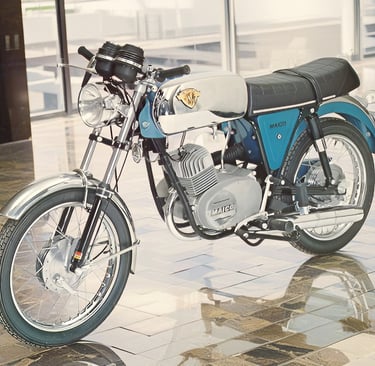The Golden Era of Maico: A Chronicle of Racing Success and Engineering Prowess
The article explores the history and legacy of Maico motorcycles, highlighting their racing success, engineering innovations, and foray into manufacturing small scooters and mopeds. From their inception in 1926 to the golden era of racing in the 1970s and 1980s, Maico motorcycles made a lasting impact on the motorcycle industry, despite facing challenges that led to their eventual decline.
GERMANY TWO STROKE1950'SVINTAGE MOPEDSMAICO
4/17/20243 min read


The Golden Era of Maico: A Chronicle of Racing Success and Engineering Prowess
Introduction
Maico motorcycles hold a revered spot in the annals of motorcycle history, embodying a rich tradition of innovation, performance, and endurance. Founded in 1926 in Poltringen Germany, Maico has navigated through the highs and lows of the motorcycle industry, leaving an indelible mark on racing circuits and streets worldwide. This article delves into the inception of Maico, its gleaming era of competition success, and its venture into manufacturing small scooters and mopeds, painting a comprehensive picture of a brand that rode much more than just machines—it forged legends.
The Birth of Maico
The journey of Maico motorcycles commenced in 1926 when Ulrich Maisch founded Maisch & Co, initially focusing on manufacturing 98 and 123 cc Ilo two-stroke engines. This pivotal moment marked the inception of a company that would later evolve into one of the most iconic names in the motorcycle world. The end of World War II brought significant changes to Maico's direction. Seizing the post-war opportunity to meet the increasing demand for personal transportation, Maico transitioned from engine production to assembling full-fledged motorcycles. This move not only diversified Maico's product line but also set the stage for its foray into the realm of motorcycle racing and innovation.
Golden Era of Racing Success
Maico's foray into the competitive world of motorcycle racing was not only a testament to its engineering prowess but also a defining chapter in its storied history. The brand became synonymous with victory on the racetracks, especially in the motocross scene. Maico motorcycles, with their superior handling, power, and durability, became the machines of choice for many champions.
The spotlight on Maico's racing success shone brightly in the 1970s and 1980s, a period often considered the golden era of Maico motorcycling. During these years, Maico bikes, renowned for their simplicity, speed, and modification potential, frequently topped the podium in various national and international competitions. This era underscored Maico's commitment to excellence in the highly demanding and evolving world of motorcycle racing, solidifying its legacy as a formidable competitor and innovator.
The Maico Innovations: Small Scooters and Mopeds
While Maico is often celebrated for its racing prowess and high-performance motorcycles, the company also made significant contributions to urban mobility with its range of small scooters and mopeds. The Maicoletta motor scooter, produced from 1955 to 1966, stands out as a notable example. Lauded by motorcycle enthusiasts and journalists alike for its robust build and superior riding experience, the Maicoletta was affectionately dubbed the 'Rolls Royce of scooters'.
Apart from the Maicoletta, Maico expanded its urban mobility solutions with other small scooters and mopeds designed for the everyday commuter. These vehicles were engineered with the same commitment to quality and performance that characterized Maico's racing machines, albeit on a smaller scale. These ventures into scooters and mopeds exemplified Maico's adaptability and its efforts to cater to a wider range of mobility needs, further cementing its legacy in the motorcycle industry.
Challenges and Legacy
Despite Maico’s undeniable impact on the motorcycle racing world and its innovations in the domain of small scooters and mopeds, the company faced significant challenges. Managerial decisions, market dynamics, and competition pressures led to tumultuous times, eventually contributing to the company’s difficulties in maintaining its market presence. However, the challenges could not overshadow Maico's remarkable legacy.
Today, Maico is remembered not just for its competitive success but also for its role in advancing motorcycle technology and design. The brand's commitment to excellence, innovation, and the spirit of competition lives on in the motorcycles it produced, which continue to be revered by enthusiasts and collectors around the world. Maico motorcycles serve as a testament to a bygone era of motorcycle ingenuity, reminding us of the profound impact a single brand can have on the evolution of motorcycling.
Conclusion
As we look back on the storied journey of Maico motorcycles, it's clear that this German brand has left an indelible mark on the motorcycle industry. From its early days in Poltringen, Germany, Maico carved out a niche for itself that encompassed not just the high stakes world of motorcycle racing but also the urban mobility sector with its innovative scooters and mopeds. Despite facing challenges that eventually led to its decline, the legacy of Maico motorcycles continues to resonate within the motorcycle community. Enthusiasts and collectors alike cherish the brand for its engineering excellence, racing heritage, and the joy it has brought to riders around the globe. Maico’s story is a testament to the enduring impact that a company can have on its industry, inspiring future generations of riders and engineers to push the boundaries of what's possible on two wheels.
